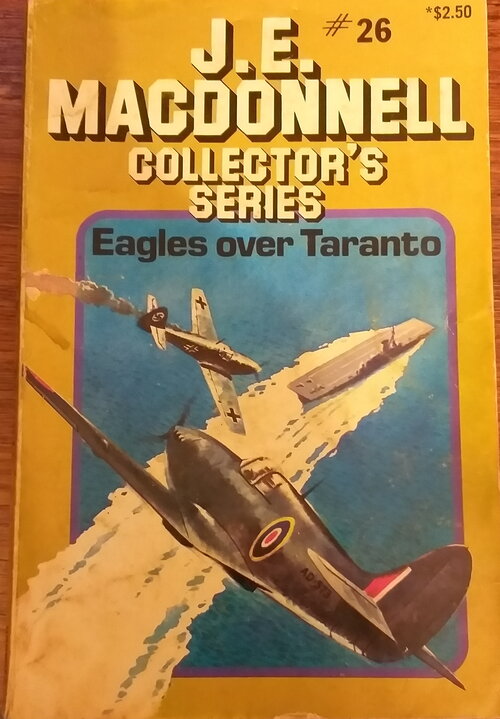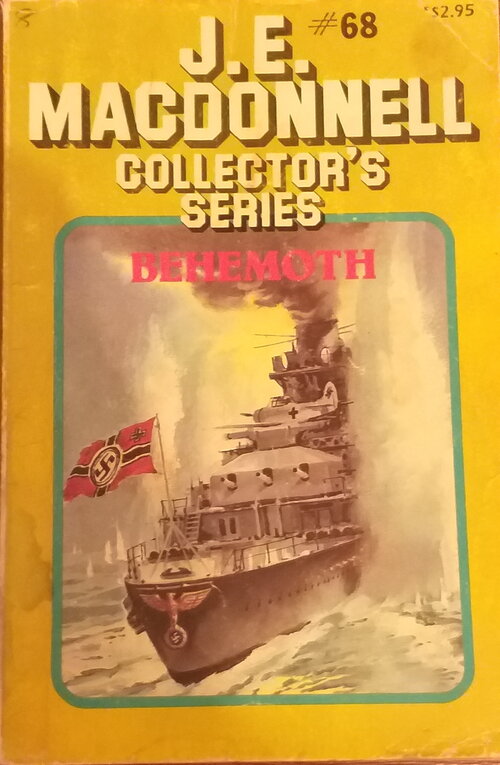- Joined
- 16 December 2010
- Messages
- 3,756
- Reaction score
- 4,101
J. E. MacDonnell, Caribbean Striker (Mark Hood: 6), 1967
United States
USS Thomas F. Brewster
'Destroyer' (DDGN), class not specified
Engines: Nuclear (1 Reactor powerplant)
Length: 400ft (121.92m)
No other details
Unnamed
Prototype Surface Effect Ship
Armament: Sufficient M-1 Carbines to equip the crew.
Description: "It was a flat circular vessel with a rounded bow."
Speed: "She's a hydrofoil Mark. Moves on a cushion of air, something the same principle as a hovercraft. Hover! Brother... In that bulb of a hull are gas and turbine engines. They'll take her from New York to England in less than a day and a half. What do you think of that?"
Notes: Little information beyond the above is provided. The craft is also described as the prototype for a series of high-speed ASW ships. I have discussed with Hood the possibility that the author is describing some form of Wing-In-Ground effect craft, but there is not enough detail to make a call one way or the other. The author simply refers to the ship as a 'hydrofoil' after it's introduction.
Plot Summary: Someone is manipulating ships guidance systems in the Caribbean causing collisions at sea and groundings, sounds like a job for Mark Hood...
Note: J. E. MacDonnell was a prolific Australian writer of action fiction for newsstand paperbacks. Some of the novels by him covered in this thread include, 'Gimme the boats!' (1953), 'The Frogman' (1958), 'Night Encounter' (1958), 'The Surgeon' (1959), 'The Secret Weapon' (1959), 'Subsmash' (1960), 'The Coxswain' (1960), 'Sainsbury VC' (1962), 'U-Boat' (1962), 'Not Under Command' (1963), 'Killer Group' (1964), 'The Snake Boats' (1967), 'Approved to Scrap' (1968), 'The Hammer of God' (1968), 'Petty Officer Brady' (1968), 'Hunter-Killer' (1968), 'The Last Stand' (1970), 'The Kill', (1974), 'Breaking Point' (1979), 'Jim Brady, Able Seaman' (1985) & 'The Glory Hunter' (c. 1980s) . He also wrote a series of 'James Bond' style superspy thrillers featuring an agent named Mark Hood, novels in this series that have appeared in the thread are 'Come Die With Me' (1965) and 'Operation Octopus' (1968).
United States
USS Thomas F. Brewster
'Destroyer' (DDGN), class not specified
Engines: Nuclear (1 Reactor powerplant)
Length: 400ft (121.92m)
No other details
Unnamed
Prototype Surface Effect Ship
Armament: Sufficient M-1 Carbines to equip the crew.
Description: "It was a flat circular vessel with a rounded bow."
Speed: "She's a hydrofoil Mark. Moves on a cushion of air, something the same principle as a hovercraft. Hover! Brother... In that bulb of a hull are gas and turbine engines. They'll take her from New York to England in less than a day and a half. What do you think of that?"
Notes: Little information beyond the above is provided. The craft is also described as the prototype for a series of high-speed ASW ships. I have discussed with Hood the possibility that the author is describing some form of Wing-In-Ground effect craft, but there is not enough detail to make a call one way or the other. The author simply refers to the ship as a 'hydrofoil' after it's introduction.
Plot Summary: Someone is manipulating ships guidance systems in the Caribbean causing collisions at sea and groundings, sounds like a job for Mark Hood...
Note: J. E. MacDonnell was a prolific Australian writer of action fiction for newsstand paperbacks. Some of the novels by him covered in this thread include, 'Gimme the boats!' (1953), 'The Frogman' (1958), 'Night Encounter' (1958), 'The Surgeon' (1959), 'The Secret Weapon' (1959), 'Subsmash' (1960), 'The Coxswain' (1960), 'Sainsbury VC' (1962), 'U-Boat' (1962), 'Not Under Command' (1963), 'Killer Group' (1964), 'The Snake Boats' (1967), 'Approved to Scrap' (1968), 'The Hammer of God' (1968), 'Petty Officer Brady' (1968), 'Hunter-Killer' (1968), 'The Last Stand' (1970), 'The Kill', (1974), 'Breaking Point' (1979), 'Jim Brady, Able Seaman' (1985) & 'The Glory Hunter' (c. 1980s) . He also wrote a series of 'James Bond' style superspy thrillers featuring an agent named Mark Hood, novels in this series that have appeared in the thread are 'Come Die With Me' (1965) and 'Operation Octopus' (1968).
Last edited:




